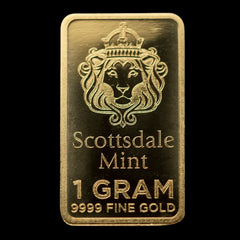Key Takeaways:
- Gold Serves As A Safe-Haven Asset: Tariffs and broader economic uncertainties often drive investors toward gold for its ability to preserve wealth and provide portfolio diversification.
- Gold Prices Tend To Rise During Trade Wars: Historical data shows that gold typically performs well during market volatility and inflation concerns triggered by tariff-related disruptions.
- Gold Is Less Affected By Industrial Demand: Unlike other metals, gold’s value remains stable regardless of manufacturing trends, making it a reliable option during economic downturns or geopolitical shifts.
In times of economic tension, investors often ask whether gold is a good investment. With tariffs making headlines and global trade dynamics shifting, many are turning to gold as a proven hedge against uncertainty. Historical trends show that gold has consistently served as a safe-haven asset during trade wars and inflationary cycles, preserving purchasing power when markets become unstable.
At Summit Metals, we help investors navigate these shifting conditions by offering verified, investment-grade gold and real-time insights rooted in transparency and trust.
In this article, we’ll explore how tariffs affect gold prices, what recent trends suggest, and whether now might be the right time to add gold to your portfolio.

The Impact Of Tariffs On Gold Prices
When trade tensions rise and tariffs are introduced or expanded, they don’t just affect the cost of imported goods. They send ripples through global financial markets. For investors watching these changes unfold, one question becomes increasingly relevant: How do tariffs impact the value of gold?
Gold’s Behavior During Trade Disruption
Tariffs often introduce uncertainty into the market. This can raise manufacturing costs, reduce global trade flows, and stoke inflation fears. A climate of unpredictability tends to drive investors away from risk-based assets and toward those that offer stability and security.
At Summit Metals, we’ve seen that investor demand for gold has historically climbed during tariff-heavy periods. That’s because gold is uniquely positioned as a non-yielding, globally recognized asset that is not tied to any country's economic or fiscal policies. When volatility spikes, gold offers a level of reassurance few other assets can match.
The Relationship Between Tariffs And Currency Strength
One key mechanism through which tariffs influence gold prices is their effect on currency strength, particularly the U.S. dollar. When imposed tariffs, they often lead to inflationary pressure and shifting trade balances, weakening the dollar over time. Since gold is priced in dollars, a weaker dollar generally boosts the price of gold for international buyers, increasing global demand.
Conversely, if tariffs strengthen the dollar due to capital flight into U.S. assets in the short term, gold prices may see temporary headwinds. However, over extended periods of protectionist policy (government actions like tariffs or import restrictions designed to shield domestic industries), inflationary effects and global uncertainty tend to dominate, reinforcing gold's role as a long-term store of value.
Tariffs And Inflation: A Catalyst For Gold Demand
As tariffs raise the cost of imported goods, consumers often face higher prices at checkout. This inflationary pressure isn’t just theoretical; it affects real purchasing power. In response, investors frequently turn to gold as a hedge against inflation, recognizing its centuries-long reputation as a durable store of wealth.
At Summit Metals, we help investors capitalize on this trend by offering a curated range of verified gold bars and coins that retain their value through periods of economic adjustment, including tariff-driven price shocks. With real-time spot pricing and fully insured storage solutions, we make it easy to preserve purchasing power when inflation is on the rise.
The Bottom Line
While tariffs alone don’t determine gold prices, they often trigger wider market volatility, currency shifts, and inflation – all of which tend to elevate investor demand for physical gold. As protectionist trade policies increase, so does the appeal of tangible, sovereign-free assets like gold.
For investors seeking stability in uncertain times, Summit Metals offers transparent, reliable access to gold, backed by expert guidance, verified purity, and secure storage options. Gold remains relevant and essential in an environment shaped by tariffs and trade shifts.

Historical Performance Of Gold During Trade Wars
Gold has long been recognized as a safe-haven asset during economic instability and geopolitical conflict. Trade wars, in particular, have historically triggered sharp movements in currency values, inflation expectations, and equity markets – all of which enhance gold’s appeal. Understanding gold’s past performance during similar periods provides valuable insight for investors evaluating the current tariff landscape.
Gold During The U.S.–China Trade Conflict (2018–2019)
A clear example is the U.S.-China trade war, starting in 2018. As both countries slapped tariffs on billions of dollars in goods, global markets faced volatility and uncertainty. Gold prices climbed about 25%, from roughly $1,200 per ounce in mid-2018 to $1,500 by August 2019 (Kitco, 2019). Investors shifted to physical gold to shield against unstable currencies, rising import costs, and shaky stock markets.
Earlier Trade Conflicts And Gold’s Reaction
Gold's protective role isn’t limited to modern trade disputes. Consider the U.S.–Japan tensions of the 1980s, where retaliatory tariffs and competitive devaluation strategies contributed to currency instability and shifts in global capital flows. Gold steadily gained in popularity during this time as a store of value unlinked to any one government or monetary system.
Likewise, during the oil embargoes and stagflation of the 1970s, gold prices climbed dramatically as import costs surged, inflation spiked, and traditional economic levers failed to calm markets. Investors again turned to gold, not as a speculative tool, but as a durable hedge against geopolitical and monetary shocks.
The Broader Pattern: Gold As A Trade War Hedge
While each trade conflict has its own unique context, the market response often follows a familiar pattern: When tariffs increase and economic confidence wavers, gold demand rises. This isn’t just anecdotal. It’s a trend supported by decades of data. Gold's intrinsic, non-sovereign value, combined with its global liquidity and lack of dependence on industrial demand, makes it a consistently strong performer when other asset classes falter.
At Summit Metals, understanding historical patterns helps modern investors make smarter decisions. Whether you’re preparing for inflation, hedging against currency risk, or diversifying out of equities during a trade-heavy policy cycle, gold remains a time-tested, reliable asset.
Is Now The Time To Buy Gold?
To know whether gold is a good investment right now, we first have to look at tariffs, which reshape trade dynamics and lend momentum to broader market uncertainty. But the flip side of this chaos is a greater case for investing in gold. It’s not a strategic asset, and at Summit Metals, we believe timing matters more than long-term planning.
Gold And Tariff-Driven Volatility
Trade policy changes (particularly rising tariffs) often act as a trigger for economic uncertainty. They can lead to higher consumer prices, supply chain disruptions, decreased business confidence, and fluctuations in currency strength. Historically, gold has responded well in these environments. For instance, during the 2018-2019 U.S.-China trade war, gold prices surged over 25% as investor demand increased in response to market volatility and global recession fears. Gold offers a non-correlated hedge, unlike assets tied to industrial performance or specific fiscal policies. In other words, its value isn’t dependent on the performance of a single country or economy.
Why Gold Holds Its Ground
Gold has maintained its status as a store of value for centuries. Its appeal today lies in several key factors:
- Scarcity: Gold supply grows slowly and predictably, making it resistant to inflationary dilution.
- Global Demand: Gold is accepted and traded globally, providing deep liquidity and consistent demand.
- Stability: Gold is one of the few financial assets that holds value across every major economic cycle.
At Summit Metals, every gold bar or coin we offer is individually verified for authenticity and purity. We then price our products based on real-time spot pricing, so you can buy with clarity, not guesswork.
How Gold Compares To Other Precious Metals
Silver, platinum, and palladium also have value in precious metals portfolios, but they behave differently in times of uncertainty.
- Silver: Silver is more affordable per ounce and often favored for its upside potential, but it is also more volatile due to its industrial demand. It’s excellent for incremental weight building, but gold offers greater long-term price stability.
- Platinum And Palladium: These metals are heavily tied to auto manufacturing and industrial use. They may outperform in periods of industrial growth, but tend to underperform during recessionary or inflationary periods.
Should You Act Now?
Economic shifts don’t wait, and neither should thoughtful wealth planning. You may be concerned about inflation, global instability, or a weakening currency, but in any case, adding physical gold to your portfolio can offer measurable protection and long-term peace of mind.
At Summit Metals, we simplify the process from start to finish. You can choose from a broad range of investment-grade gold bars or coins, store them securely in our insured depository facilities, track your holdings in real time, and sell back easily when the time is right – all with the support of a team committed to transparency and trust.

Final Thoughts
Given today’s uncertain global economy and the recent spotlight on tariffs, many investors are turning to gold as a powerful investment vehicle.
Time and again, gold has proven highly valuable, serving as a portfolio anchor when inflation or political tension clouds the horizon. Its historic resilience during trade conflicts, independence from industrial demand, and global recognition make it a powerful hedge for investors seeking long-term security. Whether you're protecting purchasing power, diversifying your portfolio, or preparing for future uncertainty, gold remains a wise investment. When you’re ready, Summit Metals is here to help you invest with confidence, clarity, and control.
Read also:
- How the Trump 2024 Election Impacts Gold & Silver Investing
- Price Of Gold And Silver Bullion: Essential Investments For Wealth Protection Amid Economic Uncertainty In 2024
- Buy Physical Gold: The Growing Power Shift In The Gold Market From East To West
Frequently Asked Questions About If Gold Is Still A Good Investment
Do central bank gold purchases affect the market during tariff implementations?
Yes, central bank gold purchases can significantly influence the market, especially during tariff-driven uncertainty. When central banks increase their reserves in response to global tension, it signals reduced confidence in fiat currencies and often contributes to upward pressure on gold prices. In tariff-heavy environments, this institutional demand compounds with private investor interest, reinforcing gold’s reputation as a safe-haven asset. At Summit Metals, we closely monitor these macroeconomic indicators to help investors make informed decisions based on evolving global trends.
Will continuing global tariffs drive gold prices higher?
While every market response is nuanced, global tariffs tend to disrupt trade flows, increase uncertainty, and spark inflationary concerns. All of these factors historically support higher gold prices. Gold often benefits as risk appetite decreases and central banks or individual investors seek assets unrelated to specific economies. While no trend is guaranteed, extended tariff regimes generally enhance gold’s appeal by increasing demand for stability and real, tangible value.
Is the correlation between gold and tariffs consistent across different economies?
Not entirely. The impact of tariffs on gold demand varies by region. In export-heavy or currency-vulnerable economies, tariffs may trigger more dramatic shifts toward gold as a defensive asset. In contrast, countries with stable currencies or broader economic buffers might experience a more muted response. Still, on a global scale, gold consistently rises in relevance during trade disruption, serving as a universal hedge against geopolitical and monetary uncertainty.
Should I increase my gold holdings due to the current tariff situation?
That depends on your financial goals and risk tolerance. Tariffs often create the kind of uncertainty that makes gold shine, whether through inflation, currency volatility, or equity market stress. For many investors, this is a signal to diversify with physical gold, especially as part of a broader strategy focused on capital preservation. Summit Metals offers a range of investment-grade gold bars and coins that are thoroughly verified for purity and authenticity, as well as secure depository storage and support from a knowledgeable team. Still, consulting with a financial advisor before adjusting your portfolio allocation is wise.
How does the relationship between the dollar and tariffs influence gold investments?
Tariffs can weigh on the U.S. dollar, particularly if global trade partners retaliate or investor confidence in U.S. growth declines. Since gold is priced in dollars, a weaker dollar typically boosts the metal’s price, increasing its attractiveness to domestic and international buyers. While this relationship isn't absolute and short-term movements can vary, it’s a key reason gold remains a preferred asset in environments shaped by monetary pressure and global trade tension.
Are tariffs creating better opportunities for gold investors?
Yes. Rising trade tensions and prolonged tariff disputes often create favorable conditions for gold investors. With market volatility rising and inflation becoming a growing concern, many are turning to gold to anchor their portfolios. Summit Metals makes it easy to capitalize on these opportunities by offering transparent, real-time pricing, verified bullion, and fully insured storage solutions, giving investors the tools they need to act confidently, even in uncertain markets.






